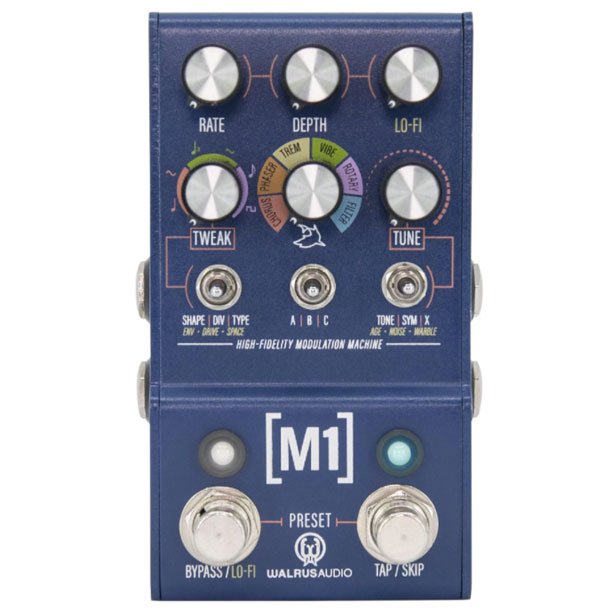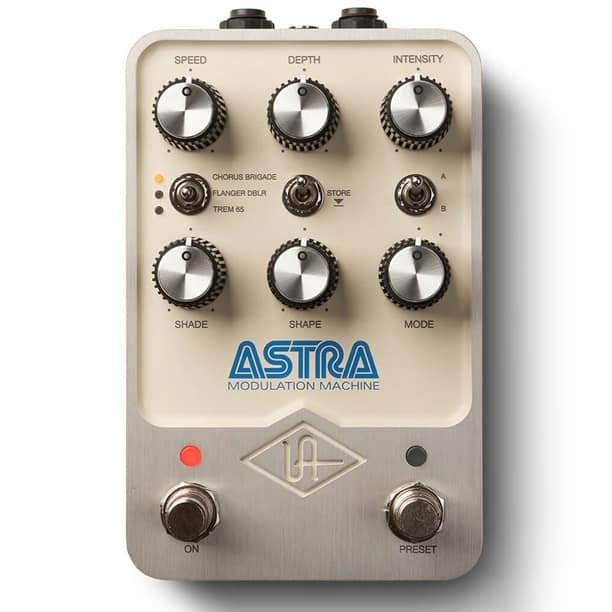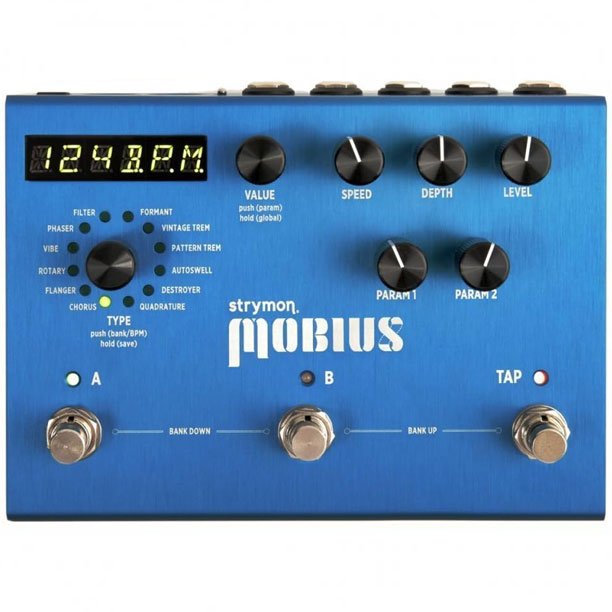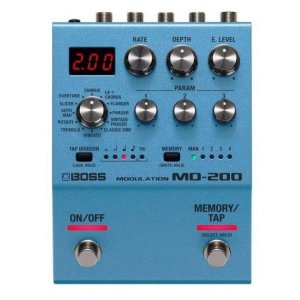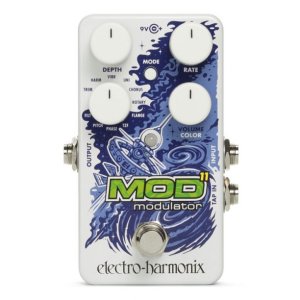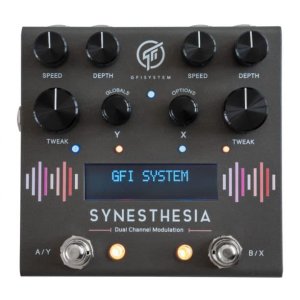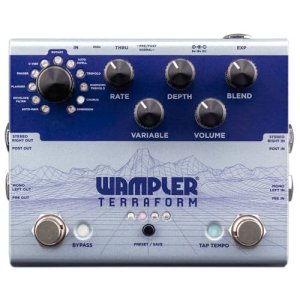Modulation effects such as Chorus, Phaser, Flanger, Vibe, and Tremolo can infuse your synth sounds with rich character, especially when experienced in stereo. In this video/article combo, we’ll delve into a comparison of seven top-notch multi-mode modulation pedals available in the market.
“Multi-mode” signifies that these pedals are exceptionally versatile digital effects, capable of delivering more than one type of modulation. This sets them apart from the more specialized “single-use” analog pedals like your typical BOSS chorus, flanger or phaser, for which we have separate guides.
The 7 Best Multi-Modulation Stompboxes For Synths
Our collaborator Liam Killen conducted these tests using the Novation Bass Station 2 and Circuit Rhythm as his sonic canvas. The pedals were mounted on a Pedaltrain XD-18 pedalboard and powered by a Voodoo Lab Power 3 Power Supply Unit.
Walrus Audio Mako M1
The Walrus Audio Mako M1 is a highly tweakable stereo multi-modulation effect with presets and MIDI compatibility that offers Phaser, Chorus, Tremolo, Vibrato, Rotary and Filter – and three types for each! – impressively hosted in a compact case.
The two footswitches deal with Tap Tempo, preset navigation and momentary effects, which vary depending on the effect. But the real twist here is the very appealing Lo-Fi knob, which takes this device in the very hyped worn tape/crackling-warbling vinyl simulation territory. Every effect can sound perfectly hi-fi, or be tweaked to have that lo-fi “magic” that often works better in a song.
Even though the lack of a Flanger mode and an Expression Input is somewhat questionable, the way this pedal is configured makes it an incredibly versatile and inspiring effect. We find that the three voices per effect feature (accessible via the A|B|C toggle) expands its sonic palette tremendously, while the 12 (!!!) functions provided by the other two toggles linked to the Tweak and Tune knobs allow the player to experiment with the sound’s character and quality in unique ways.
LFO shape, Subdivision, Envelope, Reverb, Drive, Tone and LFO Symmetry are only a selection of the tweakable parameters, and the impressive thing is that the team at Walrus Audio was able to implement this without an LED screen – it’s all at your fingertips! There’s also an “X” function that varies depending on the selected mode, ans a Skip footswitch function that simulates the sound of a needle skipping on a record player!
Our Final Thoughts on the M1
Walrus Audio has established a reputation for crafting exceptional modulation effects. If you’re considering individual effect pedals like Choruses, Phasers, and Flangers, their highly regarded offerings are worth exploring. The M1 upholds this legacy by delivering an array of fantastic modulation effects. However, what sets this pedal apart is its unique Lo-Fi approach and enhanced versatility, making it an immensely enjoyable tool that is sure to ignite creativity in synth players who have a penchant for sonic exploration.
—
—
Universal Audio UAFX Astra
The Universal Audio UAFX Astra is a Stereo, digital, 3-mode (plus 1) multi-modulation pedal with 2 variations for each mode (A/B toggle), preset capability, and six knobs controlling Speed, Depth, Intensity, Shape, Shape and Mode. The modes include Chorus Brigade, Flanger/DBLR, Trem 65 (Blackface-style) and another downloadable at registration giving you Phaser X90 and Dharma Trem 61, for a total of 4×2 different effects.
While not necessarily tailored for synth players (notice the absence of Midi functionality and the limited tweakability), the Astra is a sonic gem, particularly when it comes to enriching extended pad sounds. Among the pedals we explored for this article, it stood out as the most authentically analog, delivering timeless modulation effects that exude subtlety and sophistication – much like the pedal’s aesthetic charm.
The Astra’s analog quality is the result of Universal Audio meticulously modeling each mode after revered vintage analog units, including two bucket-brigade classics: The Chorus Brigade mode mirrors the legendary first-ever BOSS chorus, the CE-1 Chorus Ensemble; The Flange/Doubler mode pays homage to the beloved ’70s MXR rack unit with the same moniker; the Trem 64 takes inspiration from the tremolo circuits installed in the Fender amps of the ’60s, emulating even the interaction between the optical circuit of the tremolo and the amp’s tube.
All these effects can be reproduced in their authentic “version” faithful to the original or modified for more unusual textures with variable sine and square wave settings.
Our Final Thoughts on the Astra
In contrast to the other two pedals in this top 3, the Astra takes a different approach. It’s not a creative juggernaut, nor is it an excessively adjustable device. Instead, it falls into the category of “less is more,” offering a select range of exceptional modulation effects in their classic and timeless manifestations.
—
—
Strymon Mobius
A fully stereo, studio-grade pedal with extensive MIDI capability, presets (200 of them!) and assignable knobs and expression pedal input, the Mobius is a modulation powerhouse boasting 12 different effects – from the classic to the “out there” – each featuring several “sub-modes.”
Featuring five front-panel knobs – Speed, Depth, Level, Param 1, and Param 2, which can be customized per preset – the Mobius boasts a simple LED screen for detailed editing of various parameters. This comprehensive interface allows you to fine-tune a noteworthy number of settings without resorting to an overly complicated menu navigation.
Strymon has earned a legendary reputation for its rich DSP-powered effects, and the Mobius lives up to that legacy. None of the classic effects in its arsenal, from lush choruses to pulsating tremolos to swirly flangers and hypnotic phasers, sounds remotely digital to our ears.
In addition to these staples, the Mobius introduces unconventional and quirky effects designed to cater to musicians with a penchant for sonic exploration, and therefore synth players, who, more than guitarists, are inclined to be sound designers. These unique offerings set the Mobius apart, making it a versatile pedal that offers both foundational tones and experimental effects for inspiration. Examples include Quadrature (amplitude/frequency modulation), Destroyer (bit crushing + sample reduction), or Formant (vowel formant-based modulation).
Another very useful feature of this pedal is the Pre/Post mode, which lets you convert the stereo routing into a double, switchable mono one, allowing you to place the pedal in two different locations at the push of a footswitch, without having to rewire anything.
Our Final Thoughts on the Mobius
Although the oldest and largest unit in this top 3, the Mobius is still a fantastic-sounding device with features that are hard to beat for their comprehensive approach to sound design. It’s a pedal that will satisfy the purists and the explorers, and keep both types of musicians happy for a while.
—
4 More Pedals Also Worth Considering
While the three pedals covered up until now are Liam’s favorite, these four are also exceptional alternatives that might work perfectly well depending on your needs.
The BOSS MD-200 (revidewed by Liam here) sticks to the classic modulation effects offered by the classic, single-effect compact BOSS stompboxes. Four memory slots hold your presets. Routing includes stereo and MIDI I/O, dry analog output, and optional expression pedal. Three mode-dependent knobs integrate controls for Rate, Depth and Level. It’s quite affordable for all it does.
The Electro-Harmonix Mod 11 (revidewed by Liam here) is a bread-and-butter, affordable options with basic controls by a pioneering pedal brand, but it’s mono and lacks Midi. However, the effects sound great, and the added and fun Momentary Mode lets you switch in and out of effects mode for quick accents.
The GFI System Synesthesia (reviewed by Liam here), is the only dual modulation pedal in this list. It can run two effects in parallel as two separate channels or in series, one feeding the other, opening up an incredible spectrum of sonic possibilities. It has over 30 on-board algorithms (some of which are not modulation!) and more accessible through the SymmLab app. The various algorithms can be organized in three different DSP routing schemes, and every parameter can be controlled via Midi.
The Wampler Terraform (reviewed by Liam here) is another pedal sticking to more traditional modulation types, although its full stereo path and Midi compatibility make it palatable for synth players. It offers flexible routing, 8 presets, tap tempo, and expression pedal control. Four fixed knobs set Rate, Depth, Blend (Mix) and Volume, while the Variable control varies depending on the selected mode.
—















